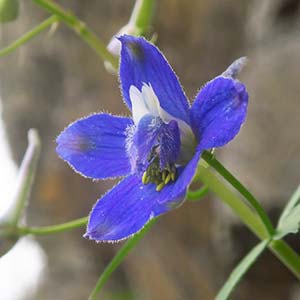Delphinium basalticum
Delphinium gracilentum
basalt larkspur, basaltic larkspur, Columbia Gorge larkspur
Greene's larkspur, meadow larkspur, pine forest larkspur, slender or Greene's larkspur
20-50(-65) cm;
base often reddish, puberulent.
(15-)30-50(-80) cm;
base reddish, nearly glabrous.
blade round, 2-6 × 5-9 cm, not succulent, nearly glabrous; ultimate lobes 5-19, width 3-15 mm (basal), 1-12 mm (cauline).
blade round to pentagonal, 1.5-4 × 3-7 cm, nearly glabrous; ultimate lobes 3-7, distinctly wedge-shaped, usually 5 or fewer extending 3/5 distance to petiole, width 5-20 mm (basal), 1-15 mm (cauline), widest in distal 1/2.
(2-)6-16(-26)-flowered;
pedicel 2-7 cm, nearly glabrous;
bracteoles 4-12 mm from flowers, green, linear, 3-7 mm, nearly glabrous.
5-20(-38)-flowered;
pedicel spreading from rachis at nearly 90°, 1-3(-4) cm, glabrous or glandular-pubescent;
bracteoles (7-)11-19 mm from flowers, blue or green, linear, 2-5 mm, puberulent to glabrous.
sepals dark blue, nearly glabrous, lateral sepals spreading, 15-21 × 7-10 mm, spur straight to decurved, ascending 30-45° above horizontal, 14-18 mm;
lower petal blades slightly elevated, ± exposing stamens, 7-9 mm, cleft 4-5 mm;
hairs centered, mostly on inner lobes above base of cleft, yellow to white.
sepals dark bluish purple to pink or white, usually retaining color upon drying, glabrous, lateral sepals reflexed, 6-10(-13) × 3-6 mm, spurs often curved upward, within 30° above or below horizontal, 8-12(-14) mm;
lower petal blades elevated, exposing stamens, 3-5 mm, clefts 1-3 mm;
hairs almost exclusively near base of cleft, centered or mostly on inner lobes, usually yellow.
12-17 mm, 3.5-4 times longer than wide, glabrous.
8-16 mm, 3-3.5 times longer than wide, glabrous to glandular-puberulent.
± wing-margined;
seed coat cells with surfaces smooth.
unwinged;
seed coats ± pitted, cell surfaces roughened.
Delphinium basalticum
Delphinium gracilentum
Of conservation concern.
Hybrids between Delphinium basalticum and D. trolliifolium are known.
(Discussion copyrighted by Flora of North America; reprinted with permission.)
Delphinium gracilentum hybridizes with D. patens subsp. patens in the northern Sierra Nevada foothills and is very similar to that species, making hybrids difficult to discern. While D. gracilentum and D. patens are easily distinguished in most of their ranges, morphologic distinctions between the two taxa are blurred in the northern Sierra Nevada foothills region, particularly in Butte County, California. Coniferous woods are preferred by D. gracilentum; D. patens subspp. patens and hepaticoideum are more often found in broadleaf woods. The former species has more widely spreading pedicels than the latter, and D. gracilentum usually has wider leaf lobes than D. patens subsp. patens. In the southern Sierra Nevada, D. gracilentum may come in contact with D. patens subsp. montanum. Though hybrids are not common, some gene flow has apparently occurred.
Sepal color phases are not stable and considerable variation occurs within populations. The type specimen of Delphinium gracilentum represents the northern, lower elevation, nonglandular, dark-flowered phase. The type specimen of D. gracilentum forma versicolor Ewan differs only by its pink or white flowers. A limited range of intermediate colors occurs, and populations may be made up of plants of a single color or several different colors. The type specimen of D. greenei Eastwood represents the southern, higher elevation, glandular (at least on pedicels) expression. The type specimen includes representatives of dark- and light-flowered individuals of this phase. The type specimen of D. gracilentum forma versicolor (not seen by the author) is the "albino" phase referred to by Greene in his description of D. gracilentum. Several of the paratypes cited by Ewan have been seen, as have a number of individuals in natural populations.
Delphinium gracilentum has been confused with D. patens or D. nuttallianum. Delphinium gracilentum may be distinguished from D. nuttallianum by its wider leaf lobes, smaller fruits, and more elongate inflorescences, and from D. patens by its wider leaf lobes, more open inflorescences, and usually shorter fruits.
(Discussion copyrighted by Flora of North America; reprinted with permission.)


